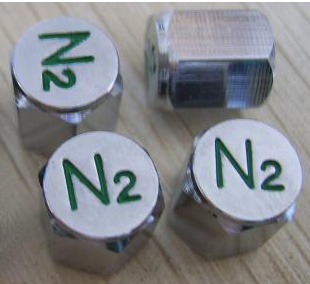*drumroll*
Nitrogen filled tires......
I was down by the tire when I noticed these bad boys on the valve-stems

Thoughts?
Moderator: Moderators

it's funny because it's true.Cereb Daithi wrote: It's a stealership. It's what they do.
What part of PV=nRT or P1V1/T1=P2V2/T2 explains that?zaxrex wrote:It has better pressure maintaining characteristics. It might not keep the temperature from changing, but the pressure won't change as much when you have temp fluctuations.
ElZorro wrote:What part of PV=nRT or P1V1/T1=P2V2/T2 explains that?zaxrex wrote:It has better pressure maintaining characteristics. It might not keep the temperature from changing, but the pressure won't change as much when you have temp fluctuations.
wikipedia wrote:An ideal gas or perfect gas is a hypothetical gas consisting of identical particles of zero volume, with no intermolecular forces, where the constituent atoms or molecules undergo perfectly elastic collisions with the walls of the container and each other and are in constant random motion. Real gases do not behave according to these exact properties, although the approximation is often good enough to describe real gases.
True, but also near phase change they start to act like real gases. Now that might sound rediculous since Nitrogen boils atElZorro wrote:I agree, those formulas aren't perfect, but as it says the approximation is good enough, there are systems designed, built and used based on them. The boundary conditions are where it would break down, extreme cold heat pressure etc. The tire of a street car is a pretty tame environment in the scope of the universe.

Yeah, I'm in the same boat. My only reason for thinking you could realate one temperature/pressure set at phase change to another is the phase-change line moves upwards (near-linear) with temperature and pressure. So as you increase both simultaneously along the phase-change line, the ability for a phase-change does not diminish.ElZorro wrote:I don't think the calculation that you carried out shows what you think it shows... that formula will tell you if you have a gas at a given state (P1 and T1) and you change the T to T2 the P becomes P2. This works from PV=nRT knows that V, n, and R are all constants. So the calculation you have would be good for estimating a hot tire pressure from a cold tire pressure (tires are 70F and at 35psi, when you get them warmed up to 80F or 90F they would increase in pressure to P2... but even this is fuzzy because you may find some volume change with the expansion of the tire)
And yea, I agree, I'm probably talking out of my @$$ as well.One year of physical chemistry and a semester of thermodynamics almost 10 years ago doesn't not make me an expert.

